Traditional Cucumber Kimchi Recipe (Oi-Sobagi)
Korean cucumber kimchi (oi-sobagi) is an essential summertime Korean side dish. This traditional cucumber kimchi recipe helps the kimchi to ferment well and stays crisp until you’ve eaten the entire batch, not to mention how easy it is to make at home.
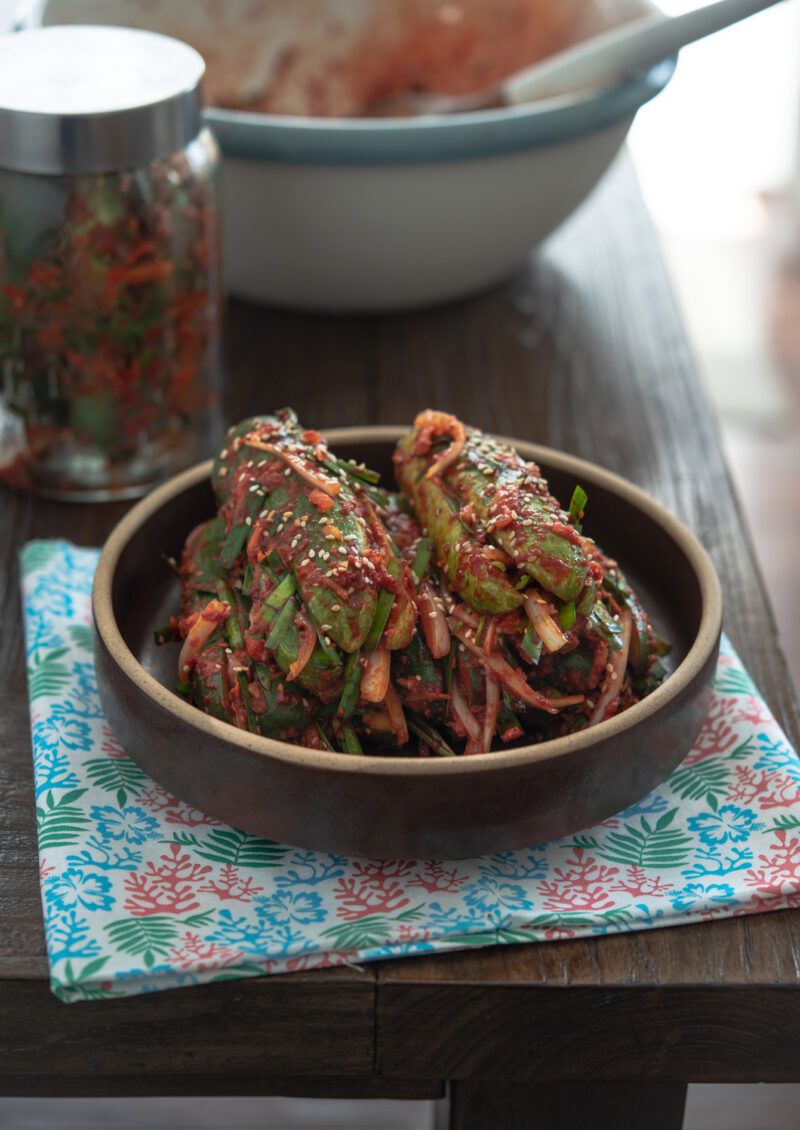
Summer is the perfect time to try making Korean cucumber kimchi, a popular banchan (side dish) in Korean cuisine. If you haven’t tried it yet, I urge you to do so and discover why so many people are hooked on this healthy kimchi made with cucumbers.
There are two types of cucumber kimchi: stuffed cucumber kimchi, also known as “Oi-sobagi (오이 소박이),” and cut-up cucumber kimchi, called “Oi Kimchi (오이김치).” If you’re looking for a crunchier option that will stay crisp longer, go for the Oi-sobagi.
This traditional cucumber kimchi recipe is known for its exceptional crunchiness, which sets it apart from other cucumber kimchi recipes. Give it a try and taste the difference!
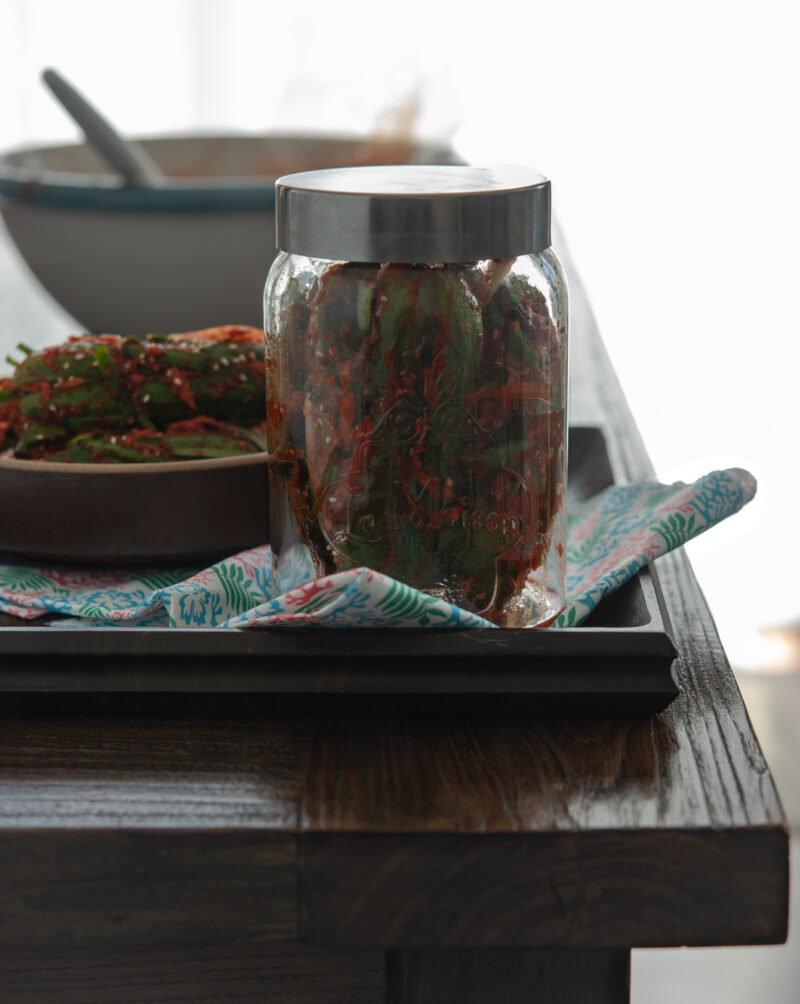
Stuffed Korean Cucumber Kimchi
Not all cucumber kimchi recipes are created equal. Many lose their crisp texture as they ferment, resulting in mushy kimchi. However, this recipe maintains its crunchiness even after the kimchi has fully fermented, ensuring that you can enjoy every bite until the last serving.
Stuffing cucumbers with kimchi filling preserves the cucumber’s texture and flavor and allows for slow fermentation, resulting in better-tasting kimchi using the traditional method. It’s almost like having spicy cucumber pickles, but with a Korean twist.
While cut-up cucumber kimchi is quicker to prepare, it ferments faster and can become mushy quickly. If you want to savor the full-bodied, crunchy flavor of authentic Korean cucumber kimchi, go with the traditional stuffed cucumber recipe. It’s easy to make and ensures a delicious result.
My cookbook, “Korean Cooking Favorites”, will share other interesting yet authentic Korean kimchi varieties. Also, don’t forget to check my different types kimchi recipes for more easy homemade kimchi ideas.
Cucumber Kimchi VS Cucumber Salad
I noticed that many people, even some food bloggers who posted cucumber kimchi recipes on their sites, are confused with cucumber kimchi with Korean cucumber salad (Oi-muchim).
They are not the same and made completely different. Korean cucumber salad is a quick side dish and it is not intended to be fermented.
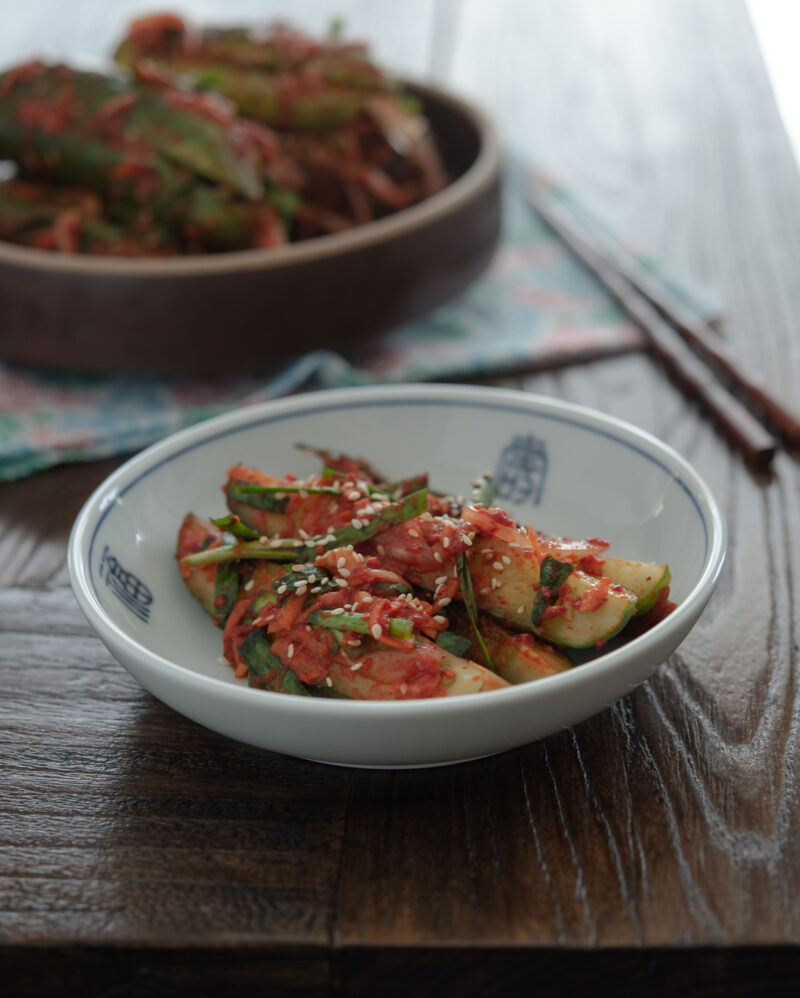
Choosing the Right Cucumbers
To make the best cucumber kimchi, it’s important to start with the right type of cucumber. Here are some options that are suitable for making stuffed cucumber kimchi:
- Korean cucumbers: These are long and slim with a pale green color and a very crunchy texture. They are widely available in most Korean grocery stores during the spring and summer.
- Kirby cucumbers: Widely used as pickling cucumbers and available anywhere.
- With a tender skin, they are suitable for making kimchi and widely available.
For this recipe, I chose Kirby cucumbers, which are ideal for making cucumber pickles that maintain their crunchiness.
Recipe Success Tips
- Use salted boiling water — Most cucumber kimchi recipes use plain salt or cold salted water. That works fine and makes good tasting kimchi up to the early stage of fermentation. However, using boiling water locks in the texture of kimchi longer.
- Would the boiling water cook the cucumbers? — Not really. It definitely softens the skin of the cucumber, and helps them lose their stiffness faster, but the boiling water will also help the salt penetrate into the cucumber faster and keeps them crunchy longer.
Ingredients List
Other than cucumbers, here are other ingredients you will need:
Cucumber kimchi filling
- Asian chives – You can substitute with green onion
- carrot – adds more texture and taste
- onion, garlic, ginger paste – savory addition
- Korean fish sauce or other fish sauce – brings umami flavor
- Korean chili flakes (gochugaru) – spicy flavor
- sugar – provides sweet balance in kimchi
- Korean plum extract (optional) – it adds another layer of sweetness.
- water and salt – to brine the cucumbers. Use coarse sea salt (Korean salt preferred)
Watch Recipe Video
How to make Cucumber Kimchi
How many cucumbers to use? It depends on the type of cucumbers — 8-10 for Kirby cucumbers, 5-6 for Korean cucumbers, or 4 for English cucumbers.
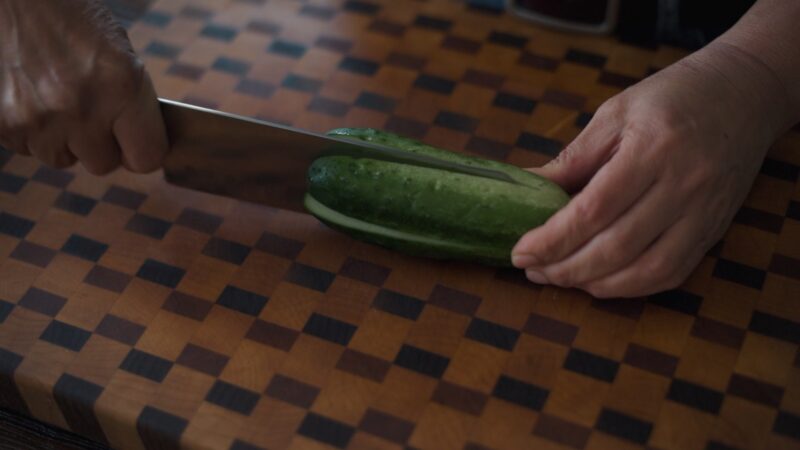
Cut through a cucumber with a sharp knife in a cross pattern, but leave one end of the cucumber uncut.
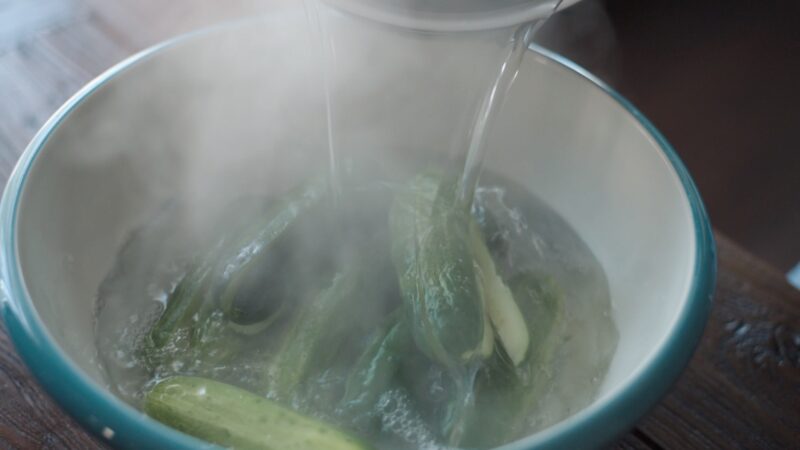
Combine water and salt; bring to boil. Pour the boiling salted water over the cucumbers in a mixing bowl.
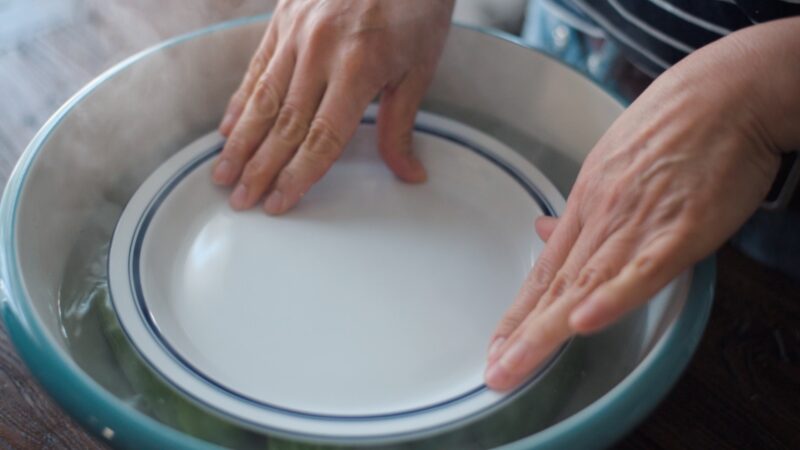
Put a weight on top of the cucumbers so that they stay immersed in the salt brine. Let them sit for 1 hour, then drain.
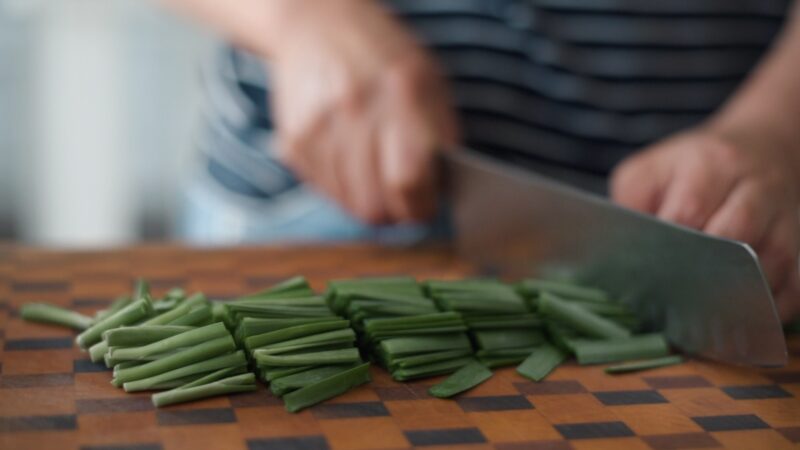
Cut Asian chives into 1 to 1 1/2-inch long pieces.
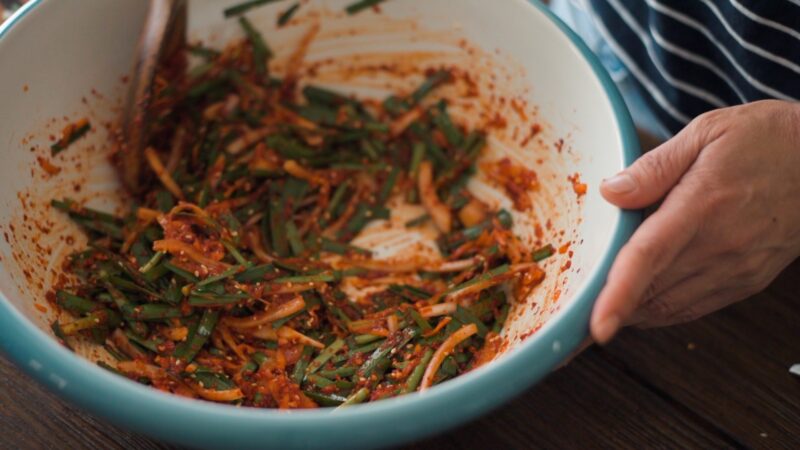
To make the kimchi filling, mix together the Asian chives, carrot, onion, garlic, ginger puree, Korean chili flakes, Korean anchovy sauce, sugar, Korean plum extract (optional), toasted sesame seeds, and water in a mixing bowl.
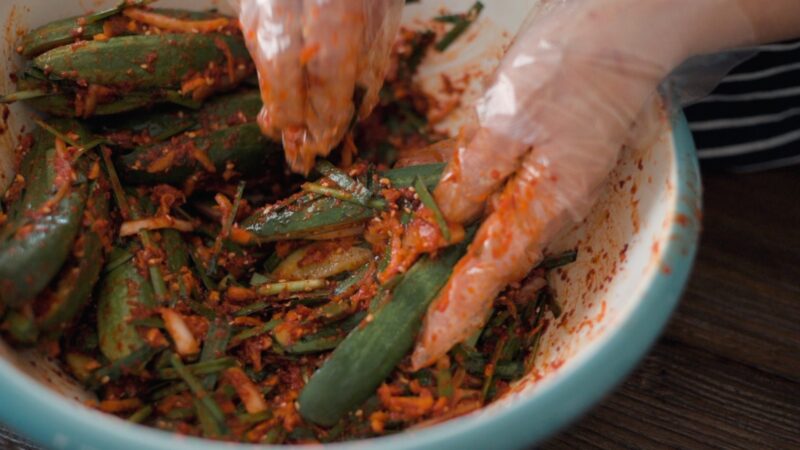
Stuff the cucumber with the kimchi filling, coating the outside of the cucumber with the filling as well.
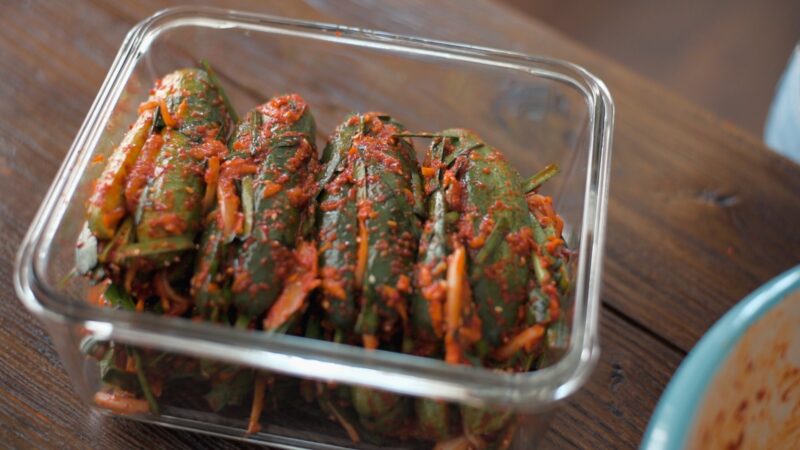
Stack the stuffed kimchi in an airtight container and cover.
Fermentation and Storage Tips
If you prefer the fresh taste, your kimchi is ready to eat right away. For a faster fermentation, leave the kimchi at room temperature for 1-2 days before transferring it to the refrigerator. The kimchi will continue to ferment slowly in the fridge.
How long will it last? If you want your kimchi to ferment quickly, leave it at room temperature for 2-3 days until it is ideally fermented. Then store it in the refrigerator and try to consume it within 2 months.
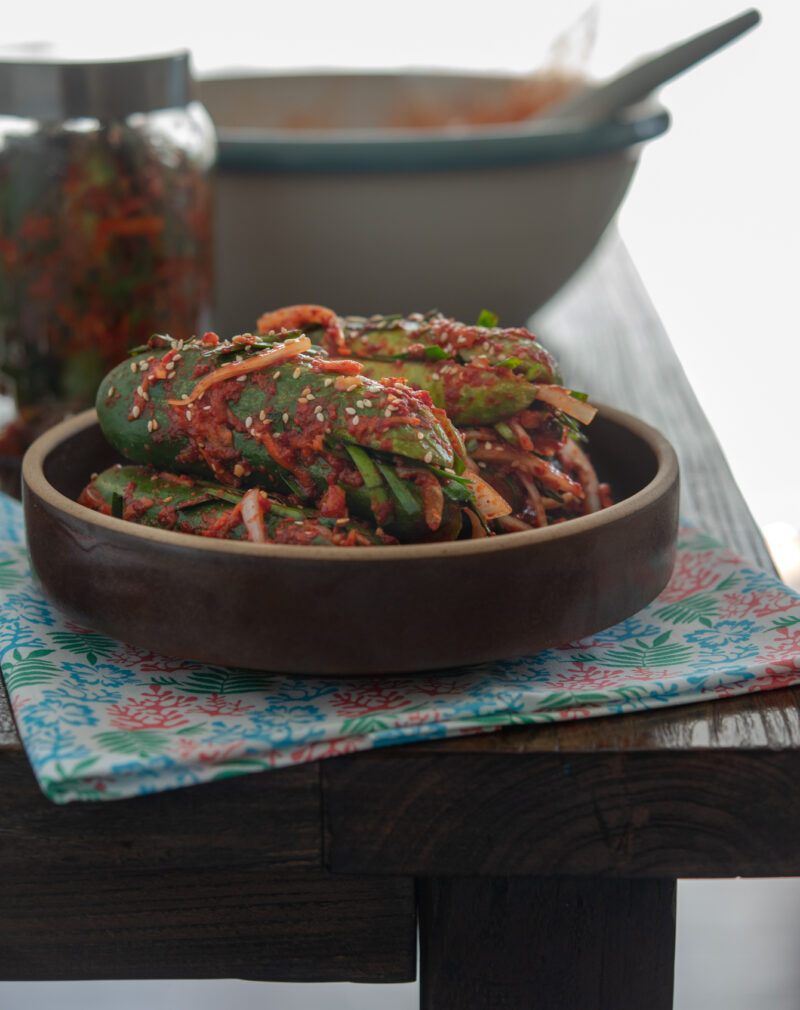
Serving Suggestions
Cucumber kimchi is a great summer kimchi, so it can go with any dishes that you enjoy during the summer. However, don’t limit this tasty kimchi to just the summer months – it’s perfectly delicious all year round.
Here are some dishes I suggest:
- Beef Bulgogi (Korean BBQ Beef)
- Doenjang Jjigae (Korean Soybean Paste Stew)
- Spicy Pork Bulgogi (Jeyuk Bokkeum)
- Jjajangmyeon (Korean Noodles with Black Bean Sauce)
- Korean Egg Rice (Gyeran Bap)
This recipe was originally posted in June 2011. I’ve updated the recipe with a few changes, new photos, and more information.

Traditional Cucumber Kimchi Recipe (Oi-Sobagi)
Recipe Video
Ingredients
- 8-10 Kirby cucumbers, 4 English cucumbers or 6 Korean cucumbers
- 8 cup (2 liter) water
- 5 tbsp Korean coarse sea salt
Kimchi Filling
- 1 1/2 cup (360 ml) sliced Asian chive, about 1-inch long
- 1/4 onion, finely chopped
- 1/2 cup (120 ml) grated carrot
- 6 tbsp Korean chili flakes (gochugaru)
- 5 tbsp Korean anchovy sauce
- 3 cloves garlic , finely minced
- 1 tbsp ginger paste
- 1 tbsp sugar
- 1 tbsp Korean plum extract (maeshil cheong), optional
- 1 tbsp toasted sesame seeds
- 1/2 cup (120 ml) water
Instructions
- Cut through a cucumber in a cross pattern, but leave one end of the cucumber uncut. Put cucumbers in a large mixing bowl.
- Combine water and salt; bring to boil. Pour the boiling salted water over the cucumbers in a mixing bowl. Put a weight on top of the cucumbers so that they stay immersed in the salt brine. Let them sit for 1 hour, then drain.
- To make the kimchi filling, mix together the Asian chives, onion, carrot, Korean chili flakes, Korean anchovy sauce, garlic, ginger puree, sugar, Korean plum extract (optional), sesame seeds, and water in a mixing bowl.
- Stuff the cucumber with the kimchi filling, coating the outside of the cucumber with the filling as well. Stack the stuffed cucumber kimchi in an airtight container and cover.
To store and ferment cucumber kimchi
- Cucumber kimchi is ready to eat right away if you like the fresh taste. If you prefer them to ferment fast, leave the kimchi at room temperature for one day, then keep them in the refrigerator after that. Within the next 2-3 days, your stuffed cucumber kimchi should be ideally fermented. Try to consume cucumber kimchi within 2 months.


Looks good
I loved this, though my family was more skeptical.
Fun, fun dish. Really creative — thanks.
They look absolutely mouthwatering! Love the idea of stuffing cucumber with kimchi. Perfect as a summer appetizer.
Hi Holly! Made this today with Korean cucumbers that I found at H Mart. It’s so easy and tasty. I love using left over rice instead of making porridge, and using hot brine is so easy! The oi sobagi that I bought at H Mart was soggy and not as good. Thank you
Thank you so much for your recipe, i made it yesterday and waiting to try it.
Great blog! Your recipes are very helpful! I’m excited to try many of these recipes for myself.
This looks like a great use for summer vegies for those of us who are kimchee lovers. I found a great recipe for kimchee tomatoes on another Korean site, http://www.Hungrygopher.com. Check it out!
Epicureanjack
Hi I love cucumber kimchi and would like to give this recipe a try.
One question, is it really necessary to use cooked rice as part of the filling? Can I omit it and still get the good taste? Thanks
Yes, you can omit the rice part. However, usually starch is used to feed the bacteria, so it helps the fermentation to more ideal level. It also helps the filling to bond better to the cucumbers, too. But you can still omit it.
Yum! I can’t wait to try this kim chee recipe. I just featured it on my round up of healthy Gluten Free Asian Recipes: http://dontmesswithmama.com/gluten-free-asian-recipes/.
Greetings from Colorado! I’m bored to death at work so I decided to browse your site on
my iphone during lunch break. I love the knowledge you provide here
and can’t wait to take a look when I get home. I’m surprised at how quick your blog
loaded on my cell phone .. I’m not even using WIFI,
just 3G .. Anyways, wonderful site!
I just made a batch of these the other day with English cucumbers and it turned out so good!! I couldn’t stop eating them so i just made another batch with Kirby cucumbers. I didn’t have the radish and korean chives so I just used regular chives and shredded carrots. Probably not as good as the original recipe but still excellent! Oh and I just realized I posted here two years ago as well. I consistently come back to your blog for recipes again and again. Thank you again for sharing all your wonderful recipes. Your cooking really reminds me of my moms which I cannot get anymore so I am able to recreate a lot of the tastes i grew up with through your blog.
How long can cucumber kimchi last?
About 1 month.
I made this today… and it’s delicious! I can’t wait to taste it three days from now!
I made it, I made it! I’m so excited. Thank you! (and bc I didn’t have any daikon radish in the house–and because when I went to the Korean store, the daikon radish were the size of small children, I didn’t buy any–I julienned some western radishes, which I hope won’t make too large a difference). It’s fermenting now. Picture here:
http://www.flickr.com/photos/cristine/7491149410/in/photostream
Hi Holly!
I love your blog. Thanks for the patience and details you put in your recipes.
I want to make this kimchi, although where I live it is difficult to find proper ingredients.
I don’t think I can get salted shrimps. If I’m lucky I can get some SE asian shrimp paste for the shelf…do you think it is a acceptable substitute? In this case, do you have a suggestion?
I need to use daikon instead of korean radish and thai fish sauce for korean. Asian chives are also a rarity. Can I do with regular chives or just scallions?
I found some korean ground pepper, it is very mild, maybe my Aleppo pepper is spicier.
Sometimes I miss living in the US so it’s easier to find Asian ingredients than Europe (at least where I’m living right now).
Thanks so much.
Hi Francesca
I know it is hard to find the right Korean groceries in Europe. But You can make a decent dish with the substitutions. You can take off the salted shrimp from the recipe, instead increased the amount of fish sauce. However Thai fish sauce is much saltier than Korean fish sauce so you need to juggle the amount to balance. You can add the tiny bit of SE Asian shrimp paste, like belachan, to this kimchi but I don’t think it is necessary. Also you can substitute Asian chives with scallions and Korean radish with daikon, but daikon won’t stay crunch that long. Good luck and let me know if you have further questions.
Hi Holly,
I’m back to report my result. I think I could have made a better job. My impression is that it’s not salty enough, infact the one we had yesterday night was a little mushy in a spot. I didn’t use the shrimp paste and I didn’t add more fish sauce either because I wanted to compensate the fact that thai sauce it’s saltier. The overall flavor is not very salty so I’m thinking I could have used more salt. I’ll keep in mind for next time.
Can I ask you the total weght for the cucumbers? It would be easier. I half the recipe (in my mind, I though I did ah, ah), using 750 g on net cucumbers. I don’t know what kind of cucumbers I had, no English, no kirby, but they were from the farmers market so hopefully organic.
Other thing, do korean fish sauces report the amount of salt in on the bottle as percentage? Because I noticed a big difference also in Thai sauces. I used one with 27% salt (pretty high) but I just bought another brand “the squid” with 20% salt.
Sorry to take advantage of your kindness, one last thing. Can you suggest me an american web site where I can buy a good brand of spicy korean chilli flakes?
I managed to find some at an Asian store around here (I’m in the South of France), they were selling it for kimchi, but it was less spicy than my aleppo pepper (which is very similar to the Korean pepper). I used the Aleppo pepper and my husband didn’t find it spicy enough. He is going to the States next week so I can ask him to bring back a bag.
Thanks for your help. I definitely going to make it again.
Hi Francesca
I am travelling this month so It is not easy for me to give you the exact amount of cucumber.
It is hard to tell you exactly what to do to fix the problem since you are using different types of cucumbers, chili flakes, and fish sauce. And they are the main ingredients in the recipe.
One advice I can give you on your not-so-salty enough cucumber kimchi is that, you can always pour more fish sauce over. I ALWAYS taste my filling before I assemble my kimchi so that I can adjust the sodium level. Cucumber Kimchi in general will never be salty like cabbage kimchi.
Since you took out shrimp sauce, you have to add more fish sauce to make up the difference, which might result your filling to be more liquidy and might have to add more chili flakes to even out.
I don’t know what type of cucumber you used but some cucumbers will have more water content than others and that can effect deluting the sodium level of your filling as well. Not all the cucumbers are suitable to make pickles and cucumber kimchi is not an exception.
Look or feel for the right filling consistency and taste always. It is like knowing the right consistecny of your pancake batter from the mix.
It should be paste-like without being too thick and not to loose either. If I can compare, it should be like banana bread batter consistency. Make any sense?
Most Thai fish sauce I use (can’t remember the name) are more saltier than Korean fish sauce but I bet some of them is not as salty than others. Korean fish sauce should mention their soidum amount in the bottle. If I remember correctly it is usually around 20%. If I am home I can double check but since I am travelling, I can’t.
For the online Korean grocery source, go to this site: http://www.hmart.com/
I don’t know if they do international shipping. If your husband is travelling to U.S, ask him to look for Korean chili flakes (coarse flakes) that is Korean origin. The lable on the back of the package usually mentioned that. Or look for 100% sign on the pacake (if he can’t read Korean). That usually means they used 100% something Korean. They are a lot more expensive than Chinese or Mexican chili origin, but for me it is worthy. Since he is getting the chili flakes, I think it is good idea to get Korean fish sauce, and other Korean condiments if he is willing.
I hope you get the kirby cucumbers and Korean chili flakes and sauces, so you can give this another try. It is very good kimchi to master.
Good luck and let me know if you need further assistence.
Thanks Holly,
I really appreciate your help. I’ll wait untill my husband is back with the right pepper and fish sauce to give it another try.
I also wanted to try your bai tsai (bok choy) kimchee but I’m giving up…I’ll better enjoy more foie gras untill I’ll be living here 🙂
I can always come and read your blog and dream of the things I cannot cook at the moment. If we move back to the States next year it would be easier.
Have a wonderful summer and happy travelling.
Francesca
Thank you so much! I just got married last month to a man who is half Korean and though I'm a great cook I'm not familiar with any of the things he loves. His mother gave me instructions for cucumber kimchee that were not very detailed and your blog is very similar to her recipe but with real instructions! I just put up a batch tonight and my husband is so excited! Thank you so much!!!!!!
So happy to hear that. Thanks for your compliment.
I hope you can try the cabbage kimchee when the weather gets cool. Have a great summer!
I initially made this roughly a month ago. This being the third cucumber kimchee recipe i tried. After a few days of fermentation I wasn't too thrilled about it. I FORGOT about it in the fridge, until a few hours ago, and o my goodness it is the Best I have ever had. I have since made my household taste it and they are all in love. Considering my results with first the baby radish kimchee and now the cucumber kimchee I am super looking forward to attempting your baechu kimchee. Your recipes are seriously gold. Thank you so very much!
I will be making this today with cucumbers from my garden that I didn't know what to do with. Also, I LOVE your blog. I'm Korean, but never learned how to cook a lot of korean food. Your blog helps me so much. I've already made kimbab and japchae from your blog for parties and get togethers with great success. Thank you so much!
Yes it does, thanks a bunch! I'll just set some rice aside next time I make it.
@a3497a7f3dce50f34988086cc16dd3a0:disqus
Hi Meagann
Of course you can use rice flour but you need to cook with water to make glue like consistence. That's why I introduced using cooked rice instead. A lot easier and quicker. You can absolutely use leftover rice, perhaps heated in the microwave for a few seconds to bring to a room temperature. Cold rice doesn't blend well.
Hope this helps.
Could I use Mochiko Rice flour mixed with water instead of cooked rice? If I must use cooked rice, can it be cold and leftover or do I need to cook it fresh?
Ha ha ha, Thank you. Hope you can try this recipe soon. It is not that difficult but needs a little patience to stuff the cucumbers. Have a fun!
You are a master at recipes that seem so effortless and quick. I will have to try this recipe as soon as I can get a bunch of cucumbers from the market!
Thanks Hyosun. How are you doing these days?
Looks delicious! My mouth is watering. It's so cute your 10 year old loves this spicy kimchi even if she has to drink milk after each bite. Great post!
@b242d4ab0aa084a244da11952bac331c:disqus
Hi Christy
Thanks for following my blog. I am glad that you like it. Hope you can try this recipe soon. It is really good.
Aesoon
Good to hear from you again. It is hot here, too, over 100 degree.
I miss HK and all my friends there. Please, let me know how the kimchee turn out when you make them.
@6d3e5ca3449c0226aceacb56d0fd7115:disqus
I am so glad to hear that you like the kimchee recipe. Don't eat too much in one sitting though. You can suffer later… 🙂
Hi H. Thanks for this recipe. I've made cucumber kimchee in the past and it always turned out mushy. Now I know the secret…can't wait to make this. FYI, Hong Kong has gotten unbearable hot.
Wow, I must try this sometime this summer. By the way, I tried your spring cabbage kimchi, and oh boy was it delicious. My korean friends and I ate a whole jar in one sitting!
Erica Sommermann
Where in Korea are you staying? Have a fun. Enjoy lots of good old Korean food.
I miss cold noodles.
cindy ensley
Oh, yes, those low table… my childhood meal table.
I never met anyone who doesn't like cucumber kimchee yet. They are good, aren't they?
@ff5a7342455262aefc19b0703b5a1649:disqus
Thanks. I miss the cool air. Spring went so fast.
i just started following your blog a few weeks ago and looove it! i definitely want to try this recipe; it looks soooo good! cucumber kimchee is my favorite type of kimchee 🙂
ahhh, i have been meaning to make oisobagi for a long time…this looks so good! thanks for the great tips! i will have to try some when i visit Korea this summer in August!
this is my very favorite type of kimchi! i remember asking my mom to make it all the time when i was a kid (i also loved sitting at our low table on the floor for korean dinners!). this is also the first kimchi i learned to make. next time i make it i will definitely employ the hot salt water method! thanks for sharing!
We're experiencing winter here, but I want to eat this kimchee anyway! Looks so good!
Awesome!! Thanks!